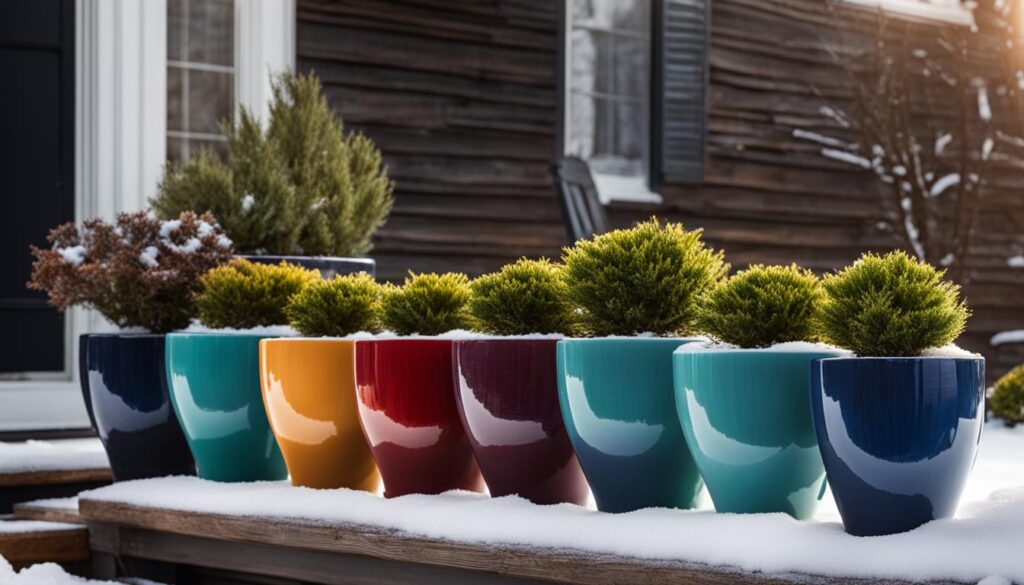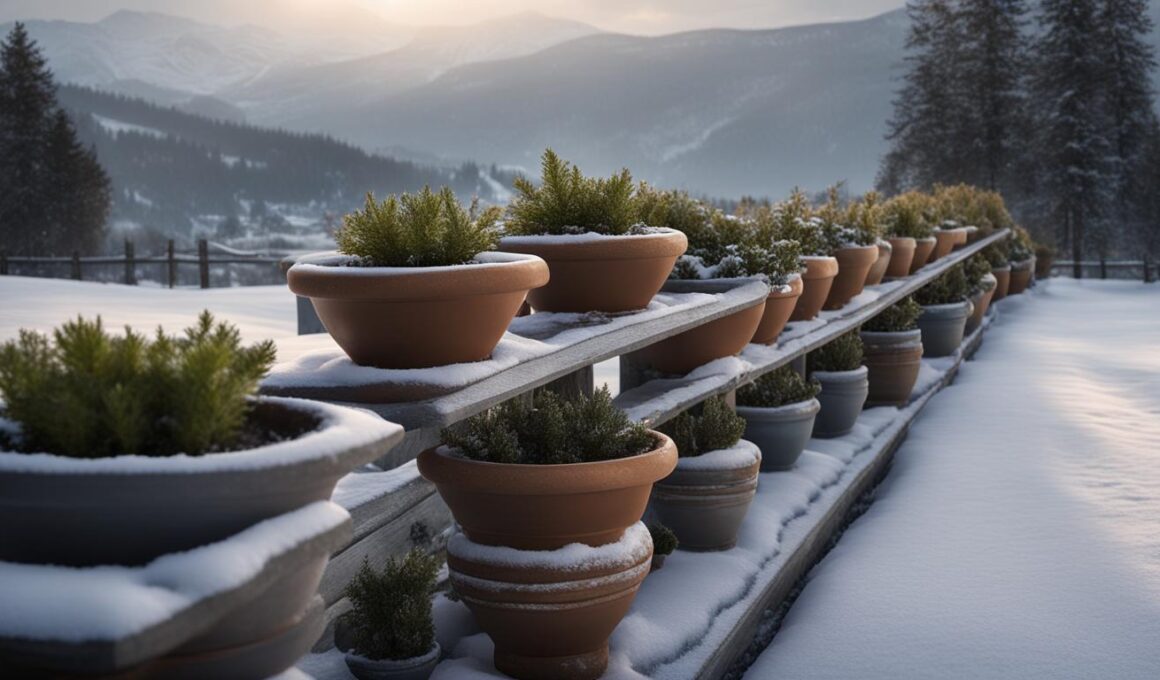Are you wondering if it’s safe to keep your ceramic planter pots outside during the winter? You’re not alone. Many gardeners have the same question. In this article, we’ll explore the best practices for storing ceramic planter pots during the cold winter months.
Post Summary:- Ceramic planter pots, especially terracotta pots, are not recommended to be kept outside in the winter time.
- Glazed pots can be left outside, but proper drainage is essential to prevent cracking due to freeze-thaw cycles.
- Concrete pots are generally safe to stay outdoors, but it’s still advisable to protect them from potential damage.
- Plastic, resin, and fiberblend pots are frost-proof and can be left outside, but cleaning them before storage is recommended.
- Before storing your pots for the winter, make sure to clean them to prevent the survival of diseases and pests.
Storing Terracotta Pots in Winter
If you have terracotta pots, it is important to store them properly during the winter to prevent cracking and damage. Terracotta pots are porous and can absorb moisture, which can freeze and lead to breakage. To store your terracotta pots, follow these simple steps:
- Start by cleaning the pots thoroughly, removing any soil or debris.
- Allow the pots to dry completely before storage.
- Wrap each pot in several layers of newspaper or bubble wrap to protect them from impact.
- Store the wrapped pots in a cool, dry place, such as a basement or attached garage, where the temperatures will not fall below freezing.
By taking these steps, you can ensure that your terracotta pots will remain in good condition and be ready for use in the spring.
“Proper storage is essential for terracotta pots in winter. The porous nature of terracotta makes it susceptible to cracking when exposed to freeze-thaw cycles. By cleaning, drying, and wrapping the pots before storing, you can protect them from damage and ensure their longevity.”
Remember, terracotta pots should not be left outside in the winter, as the freezing temperatures can cause them to crack. By following these guidelines for proper storage, you can enjoy your terracotta pots for years to come.

Storing Glazed Pots in Winter
Glazed ceramic pots can withstand winter conditions, but proper care is still necessary to ensure their longevity. One key consideration is drainage. It is important to allow excess water to flow out of the pots, as trapped water can freeze and cause cracks. To promote good drainage, avoid using saucers that can collect water. Instead, place the pots on a hard surface or use pot feet to elevate them. This will help prevent water from accumulating and freezing at the base of the pots.
Another option is to turn the pots upside down and store them in place during the winter. This can aid in preventing water from accumulating inside and reduce the risk of cracks. Additionally, planting a winter container garden in glazed pots can help maintain proper moisture levels. The plants will help absorb excess water and prevent it from freezing and causing damage to the pots.
“Proper drainage is crucial for storing glazed pots in winter. Elevating them or turning them upside down can minimize the risk of cracks caused by freezing water.” – Gardening Expert
Overall, with the right precautions, storing glazed pots in winter can be effective in preserving their beauty and functionality. By ensuring proper drainage and considering alternative storage methods, you can enjoy your glazed pots for years to come.

Storing Concrete Pots in Winter
Concrete pots are a popular choice for outdoor planters due to their durability and versatility. When it comes to storing concrete pots during the winter, there are a few important considerations to keep in mind. While concrete pots can generally withstand freezing temperatures, they can still be susceptible to chipping or cracking if mishandled.
To protect your concrete pots during the winter months, one option is to plant a winter garden in them. Adding moisture to the pots can help regulate the temperature and prevent any extreme fluctuations that could cause damage. Additionally, the plants in the pots can provide visual interest and bring life to your outdoor space even during the colder months.
If storing your concrete pots is a concern, you can also opt to cover them with a container cover or tarp. This added layer of protection can help shield the pots from harsh weather elements such as snow, ice, and wind. Just ensure that the cover is properly secured to prevent it from blowing off in strong winds.
For smaller concrete pots, another option is to turn them upside down and store them in place. This can help prevent any water from pooling and freezing inside the pot, reducing the risk of cracking or damage. Make sure to clear the area around the pots to avoid accidentally knocking them over.
| Storage Method | Advantages | Disadvantages |
|---|---|---|
| Planting a winter garden | – Adds moisture to regulate temperature – Provides visual interest |
– Requires regular maintenance – May limit pot usage for other plants |
| Covering with a container cover or tarp | – Protects pots from harsh weather elements – Easy to implement |
– Requires secure fastening – May limit accessibility to the pots |
| Turning pots upside down | – Prevents water pooling and freezing – Space-efficient storage option |
– Requires clearing the surrounding area – Limited pot storage capacity |
Storing Plastic, Resin, and Fiberblend Pots in Winter
When it comes to winter storage, plastic pots, resin pots, and fiberblend pots have a distinct advantage over their ceramic counterparts. These materials are frost-proof, making them safe to be left outside during the colder months. However, it is still important to take some precautions to ensure their longevity.
To prepare your plastic, resin, or fiberblend pots for winter storage, start by cleaning them thoroughly. Remove any remaining soil and give them a good rinse with water. This will help prevent any potential pests or diseases from surviving and causing issues in the future.
Once clean, it is recommended to store these pots indoors to protect them from extreme weather conditions. Find a cool, dry place like a basement or garage where the temperatures will remain relatively stable. Avoid exposing them to freezing temperatures, as this can cause the material to become brittle and prone to cracking.
If outdoor storage is your only option, consider covering the pots with a tarp or container cover. This will provide an extra layer of protection against harsh winter elements and prevent any potential fading caused by the sun. Remember to secure the cover tightly to prevent it from blowing away in strong winds.
By following these guidelines, you can ensure that your plastic, resin, and fiberblend pots remain in good condition throughout the winter season. Proper storage and maintenance will not only prolong their lifespan but also prepare them for the upcoming spring when you can once again fill them with beautiful plants and flowers.
Cleaning Containers in Autumn
As autumn approaches, it’s time to prepare your containers for winter storage. Proper cleaning of your containers is essential to maintain their longevity and prevent the survival of diseases and pests. Follow these steps to ensure your containers are ready for the winter season.
Cleaning the Container
Start by emptying the container and removing any dead vegetation. If the plant did not have any disease issues, compost the vegetation; otherwise, discard it to prevent the spread of diseases. While the soil in the container can be composted, it is recommended to use fresh potting soil each year for optimal plant health.
Once the container is empty, it’s time to clean it. Prepare a solution using warm, soapy water with 10 percent bleach. This will help remove any bugs or fungus that may be lingering in the container. Scrub the container thoroughly using a brush, making sure to reach all corners and crevices. Rinse the container with clean water and allow it to dry completely before storing it for the winter.
Storing the Containers
When it comes to storing containers, different materials have different requirements. Plastic containers can be safely stored outside, but it is advisable to cover them with a tarp or container cover to protect them from the elements. Terracotta, clay, and ceramic containers, on the other hand, should be stored indoors to prevent frost damage.
For terracotta, clay, and ceramic containers, store them in a basement or attached garage where temperatures will not fall below freezing. Before storing, it’s a good idea to wrap each pot in newspaper or other protective material to prevent breakage or chipping.
By cleaning your containers and storing them properly, you’ll ensure that they are in good condition and ready for planting when spring arrives. Taking these extra steps in autumn will help maintain the health and longevity of your containers, allowing you to enjoy beautiful plants for years to come.
Storing Plastic, Terracotta, Clay, and Ceramic Containers
When it comes to storing different types of containers in the winter, there are important considerations to keep in mind. Plastic containers are generally safe to be stored outside, but it is advisable to cover them to protect them from the elements. On the other hand, terracotta, clay, and ceramic containers should be stored indoors as they are more susceptible to frost damage.
Terracotta and clay pots are porous and can crack when moisture inside them freezes and expands. To protect these containers, it is best to store them in a basement or attached garage where temperatures will not fall below freezing. Wrapping each pot in newspaper or other protective material can help prevent breakage or chipping during storage.
Similarly, ceramic containers should also be stored indoors to avoid any potential damage from freezing temperatures. Placing them in a basement or attached garage is recommended to keep them safe throughout the winter. Wrapping each container individually adds an extra layer of protection against potential cracks or chips.
| Container Type | Storage Recommendation |
|---|---|
| Plastic Containers | Can be stored outside, but cover them for added protection |
| Terracotta Containers | Store indoors in a basement or attached garage, wrapped in protective material |
| Clay Containers | Store indoors in a basement or attached garage, wrapped in protective material |
| Ceramic Containers | Store indoors in a basement or attached garage, wrapped in protective material |
By following these storage guidelines, you can protect your plastic, terracotta, clay, and ceramic containers during the winter months. This ensures they will be in good condition and ready for use when spring arrives.
Are Greenhouses Effective in Protecting Plants in Winter?
Greenhouse effectiveness in winter is a subject of interest amongst gardeners. Greenhouses provide a controlled environment that shields plants from harsh winter conditions. They trap heat and prevent frost, creating a cozy haven for delicate vegetation. With adequate insulation and ventilation, greenhouses can effectively protect plants, ensuring their growth and survival throughout the colder months.
Conclusion
In conclusion, when it comes to ceramic planter pots, it’s best to avoid keeping them outside in the winter time, especially terracotta pots. These porous pots can absorb moisture, leading to freeze-thaw heaving and potential breakage or chipping. However, there are options for other types of pots.
Glazed pots can be left outside as long as proper drainage is ensured, and the use of saucers that can collect water is avoided. Concrete pots are generally safe to stay outdoors, but it’s advisable to plant a winter garden to add moisture and maintain even moisture levels.
Plastic, resin, and fiberblend pots are frost-proof and can be left outside during winter. However, cleaning these pots and removing the soil before storing them indoors is highly recommended. By following these guidelines, you can protect your pots and ensure they are ready for planting in the spring.
FAQ
Can you keep ceramic planter pots outside in the winter time?
Ceramic planter pots, especially terracotta pots, are not recommended to be kept outside in the winter time due to the risk of cracking and breakage caused by moisture absorption and freezing. However, other types of ceramic pots like glazed pots, concrete pots, and plastic, resin, and fiberblend pots can be left outside with proper precautions.
How should terracotta pots be stored in winter?
Terracotta pots should be stored indoors in a basement or attached garage where temperatures will not fall below freezing. Before storing, it is advisable to clean the pots and remove any soil. Wrapping each pot in newspaper or other protective material can help prevent breakage or chipping during storage.
Can glazed pots be left outside in the winter?
Glazed pots can be left outside in the winter, but it is important to ensure proper drainage and avoid the use of saucers that can crack when water freezes. Placing the pots on a hard surface or using pot feet to raise them can help with drainage. Alternatively, turning the pots upside down and storing them in place is another option. Planting a winter container garden can also help keep water draining and maintain the appearance of the pots throughout the winter.
Are concrete pots suitable for outdoor winter storage?
Concrete pots can be left outside in the winter as they are typically heavy and less prone to cracking. However, over time, they can still chip or crack when moved or banged into objects. Planting a winter garden in concrete pots is a great way to add visual interest during the colder months. If storing them is a concern, covering them with a container cover or tarp can provide added protection. For smaller concrete pots, turning them upside down and storing them in place is a suitable option.
Can plastic, resin, and fiberblend pots be left outside in the winter?
Yes, plastic, resin, and fiberblend pots can be left outside in the winter as they are frost-proof. However, it is recommended to clean them out and remove the soil before storing them indoors. Plastic pots can also be stored outside, but it is advisable to cover them to protect them from the harsh winter sun that can fade their color unevenly.
How should containers be cleaned in autumn?
Before storing containers in the winter, it is essential to clean them to prevent the survival of diseases and pests. Start by emptying the container and removing any dead vegetation. Compost the vegetation if the plant did not have any disease issues, otherwise, discard it. While the soil in the container can be composted, it is recommended to use fresh potting soil each year. Clean the containers with warm, soapy 10 percent bleach water to remove and kill any bugs or fungus.
How should plastic, terracotta, clay, and ceramic containers be stored in winter?
Plastic containers can be safely stored outside, but covering them is advisable to protect them from the elements. Terracotta, clay, and ceramic containers should be stored indoors as they are more susceptible to frost damage. Terracotta and clay pots are porous and can crack when moisture in them freezes and expands. It is best to store them in a basement or attached garage where temperatures will not fall below freezing. Wrapping each pot in newspaper or other wrapping can prevent breakage or chipping.









